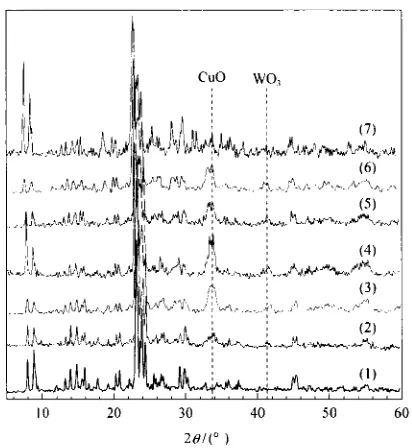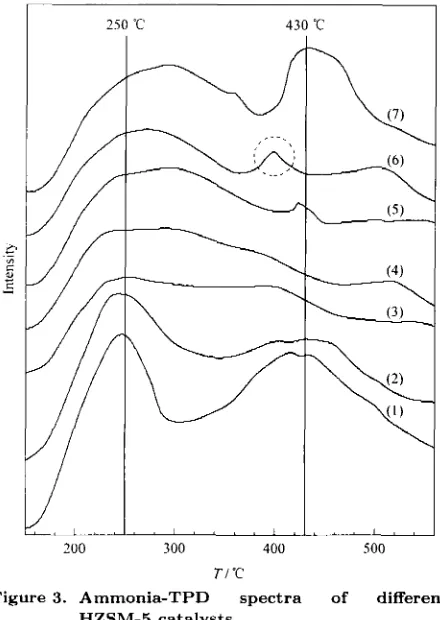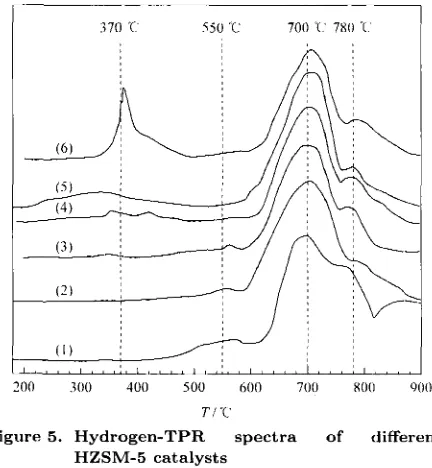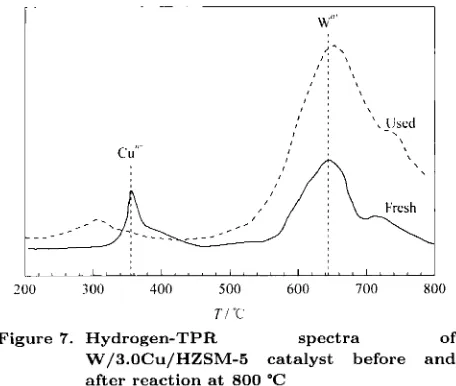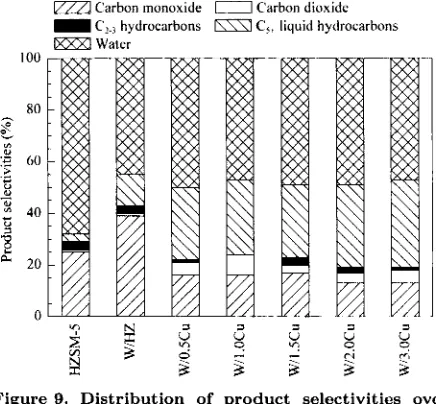Available online at www.sciencedirect.com
ScienceDirect
zyxwvutsrqponmlkjihgfedcbaZYXWVUTSRQPONMLKJIHGFEDCBA
Joiirriitl of Natural Gas Chemistry 15(2006)340 347
zyxwvutsrqponmlkjihgfedcbaZYXWVUTSRQPONMLKJIHGFEDCBA
SCIENCE PRESSArticle
Methane to Liquid Hydrocarbons over Tungsten-ZSM-5
and Tungsten Loaded Cu/ZSM-5 Catalysts
Didi
Dwi
Anggoro'*,
Nor Aishali Saidina
Arnin2
zyxwvutsrqponmlkjihgfedcbaZYXWVUTSRQPONMLKJIHGFEDCBA
1. Department of Chernical Erky.irieering, University of Diponegoro Tcmbalang, Semarang 502.39, 1ndo.riesm;
zyxwvutsrqponmlkjihgfedcbaZYXWVUTSRQPONMLKJIHGFEDCBA
2. F a c d t y of Chemical trnd Natural Resouices Engineering, lJn.zversiti Teknologi Malaysia,
Johor Bahru 81 130, Malaysiu
[Manuscript received April 17, 2006; revised July 17, 20061
Abstract: Metal containiiig ZSM-5 can produce higher hydrocarbons in metallane oxidation. Many researchers have studied the applicability of HZSM-5 and modify ZSM-5 for ruethane coriversion to liquid hydrocarbons, but their research results still lead to low conversion, low selectivity and low heat, resistancc. The modified I-IZSM-5, by loading with tungsten ( W ) , could eriharice its heat resistant performance, arid the high reaction temperature (800 "C) did not lead t o a loss of tlie W coniporicnt by sublirna,tion. The loading of HZSM-5 with tungsten and copper (Cu) resulted in an iiicrement in the methane coriversion as
well
zyxwvutsrqponmlkjihgfedcbaZYXWVUTSRQPONMLKJIHGFEDCBA
as COz and Cg+ selectivities. In contrast, CO, Ca-3 and H z 0 selectivities wcre reduced. The processof converting methane to liquid hydrocarbons (C5+) was deperideiit on the metal surface area and the acidity of the zeolite. High methane conversion and Cg+ selectivity, arid low HzO selectivit,y arc obtained over W /3.OCu/HZSM
.
K e y words: methane; liquid hydrocarbons; HZSM-5; W-ZSM-5; W-Cu/ZSM-5
1. Introduction
Tii gcIiera1, there are two routes for converting Irl(.thitlie to gasoline: indirectly or/and directly. The iiitiircct route is a two-step process whereby natural gas is first converted into synthesis gas (a mixture of 1.12 aiid CO), and then int,o hydrocarbons of the gaso- line range. The direct, route is a one step process in which t h e natural gas reacts wit,h oxygen (or another oxidizing species) to give the desired product directly. The use of the HZSM-5 zeolite as a support of the metal oxide phase is very interesting due to three rea- soils: it,s thermal stability, its high surface area t h a t eiiaMes high rnet,al oxide loading and tlie presence of acid sites that, could lead t o the formation of certain act,ive rnr:tal oxide species [I].
Ernst and Weitkamp [2] reported in a paper on
the conversion of methane over zeolite-based ciitalysts t h a t the presence of strong acid sites in the z e o h catalyst is detriment,al for t h e select,ivt: oxidation of rnethane to higher hydrocarbons; otherwise oxidized products of CO, (CO, CO2) will predoniinatc. Wheii the acidity is reduced by exchanging the zeolite with alkali m e h l cations: tlie se1ectivit)y to higher hydro- carbons is slightly enhanced. Hari et nl. [3] derriou-
strated the sucxessful production of higher hydrocnr- boils from rnethaiie oxidation using a ZSM-5 zeolitc, catalyst containing metal oxides. T h e metal oxides with sufficiently high dehydrogerition and low olc!fiii oxidation activities reduce the acidity of the ZSM-5.
As
zyxwvutsrqponmlkjihgfedcbaZYXWVUTSRQPONMLKJIHGFEDCBA
a result, thc metal containing ZSM-5 can product: higher hydrocarbons in methane oxidation.[1,4,5] discovered t h a t the ill- troductiori of Cn(I1) ions by an ion-exchangc method
De Lucas et a1.
* Corresponding author. Tel: 6224-7460058; Fax: 6224-7460055; E-mail: anggoro@aluinni.undip.ac.id
Jonrnal
zyxwvutsrqponmlkjihgfedcbaZYXWVUTSRQPONMLKJIHGFEDCBA
of Natural Gas Chrmistr:~ Vol. 15 N o . 4zyxwvutsrqponmlkjihgfedcbaZYXWVUTSRQPONMLKJIHGFEDCBA
2006 341 could rcniarkably iiicrea,se tlie activity of Mo/HZSM-5for riietliaric aromatizatioii and iiiiprove it,s stabilit,y to sonie extent. Mo species is tlie most act,ive compo- nent for nietharie iiori-oxidative aromatizatioii so far. but its activity and stability riccd to be irriprovctl.
Xiong fd al.
zyxwvutsrqponmlkjihgfedcbaZYXWVUTSRQPONMLKJIHGFEDCBA
[6,7] studied the incorporation of rnet-als Zii, Mn, La, arid Zr into tlic WIHZShl-5 cat,a- lyst. Under react,iori condit,ion of 0.1 MPa, 1073 K , GHSV of feed gas CH4 arid 10% Argon a t 960 lip'. tlie conversion of methane reached 18% 23% in the first two hours of reaction! and tlie <:orresponding se- lectivity t,o benzenc: naphthalene, cthylonc and coke was 48% 56%, IS%), 5% and 2291, respectively. Ding
et u1. [8] reported the non-oxidative rnetha,ne reactioii over WIHZSM-5 to produce C2 C12 hydrocarbons. Under the condition of 700 "C, flow ratc: CH4 and Argon a t 12.5 cni3/min, the C2 C12 selectivity was 70%-80%. However. the rnetliaiic conversion was low. just bctwceri 2% arid 3%. On tho 1)asis of the chemical siniilarities between k1oO:j and WQ3, it seems reasori- able to cxpcct a. parallelism in their catalytic proper- ties. Mo species is the most, act,ivc coiriponents for methane non-oxidat,ive aroiriatizatiori so far, but, its activity arid stJa,bilitjy need t o be improved. Recently,
we have
zyxwvutsrqponmlkjihgfedcbaZYXWVUTSRQPONMLKJIHGFEDCBA
fourid that the introdiict,ioii of Cu(1I) ionsby an ion-exchange method can remarka.bly increase the activity o f MoIHZSAl-5 for methane arornatiz;t- tion ant1 can improve itjs stability to some extent.
Cu loaded ZShl-5 catalysts ,tin acidic ion ex- change nicthod have been iderit,ifietl to be poten- tial cat,alyst,s for the conversion of nit:t,liane to liquid fuels [Y]. However, infrared study of metal loaded ZSM-5 cat,alysts indicated that tlie catalysts are not resistant to high temperatures. Previous st,udies have indicated that. metal loaded ZSM-5 did not exhibit, the vibration band at 3610 ciri-l and 3660 c i ~ i - ~ . exccpt
for the ZSM-5 which showed a weilk vi1)r;~t~iori band
zyxwvutsrqponmlkjihgfedcbaZYXWVUTSRQPONMLKJIHGFEDCBA
at3666 c n - l . The result suggested that, fraiiiework arid
non-framework aluminurn were eit,lier extracted to the acidic solution or changed to silanol defect, form when calcincd at, 800 "C and made tlie catalysts inactive [lo]. In our previous studies [11,12] it, was indicated that the Cii loaded W/ZSnil-5 c a t d y s t was thernially stable a t the reaction temperature (700-800 "C).
In this study ZSM-5 was niodified wit,h tung- sten and copper and the catalyst pcrformancc was tested for the oxidation of 1liethit1i(> t,o liquid hydro- carbons. The catalysts were characterized by XRD, T P R . TPD and N2 Adsorption iiieasurerrients. Wc:
would like t,o irivestigate the resistivity of tungsten modified HZSM-5 t o high teniptiratures and its cat,-
itlytic act,ivity for the coiiversion of rnet,hane.
2. Experimental
2.1. Preparation of catalysts
ZShl-5 zeolite with a SiO2/A120:3 mole ratio of 30 was supplietl by Zeolyst Intcrriat,iorial Co, Ltd, Nrt,lierlmds. The siirface area of tlie zeolite is
400 iii2/g. The W
zyxwvutsrqponmlkjihgfedcbaZYXWVUTSRQPONMLKJIHGFEDCBA
(3%) weight)-HZSM-5 catalystwas prcparcd 11y impregnating a certain amount of t.lie HZSM-5 xeolit,e carrier with an annrioriiiini tiirigstat,c 1iydr;itc solution [6,7]. The ariinioriiuiri t,uiig'stat,r hydrate solution was prepared by dissolv- ing (NH4)2 WO4 in deionized water and adding a small aniount of H2SO4 to regulate the pH value of the solu- tioii to 2 3. Thtl sample (10 rril of solution pes' gram zcolite) was dried in an ovcm a t 120 "C for 2 h and
then calcined at 500 "C for 4 11.
The W loaded Cu/HZSM-5 was prepared by first impregnating a certain iLtiiou1it of the HZShl-5 zeolite carrier with a calculated miourit of copper nitrate in q i i c ~ ) u s solutions, followcd by drying at 120 "C for 2 h and calcining at 400 "C for 4 h, and siibseqiieritly iiiipregiiating with a calculwted a,iriouiit of II2S04 ;tcitlified (NH4)2WO4 aqueous solution (pH=2 3 ) . Fiiidly, tlic sample WAS dried at, 120 "C for 2 h and calcined a t 500 "C in air for 5 11.
2.2. Characterization and testing of catalysts
X-ray diffractioii (XRD), H2-tcniperat,ure pro- grninnied reduchoii (H2-TPR), NHs-teniperaturc
prograniined desorptioii (NH3-TPD),
N2
zyxwvutsrqponmlkjihgfedcbaZYXWVUTSRQPONMLKJIHGFEDCBA
adsorptionand FT-IR were utilized for the characterization of t,hc catalysts. XRD arid FT-IR were employed to de- toriiiine the zeolite structure. NH3-TPD provided the acidity of the catalyst samples. H2-TPR, d a t a were pertiiieiit t o the zeolit,e morphology.
Thc. performance of tlie cat,alysts was tested for nict,lianr conversion to liquid hydrocarbons (LHC)
'via a single step reaction in a fixed-bed micro re- actor. Methane with 99.9% purity was reacted a t atmospheric prcwiire arid various temperataims arid oxygen concentration. A n on-line gas chromatogra-
phy wit,li R
zyxwvutsrqponmlkjihgfedcbaZYXWVUTSRQPONMLKJIHGFEDCBA
T C D arid a Porapak-N column was utilizedto malyze the gas. Thc liquid product was analyzed iisiiig the G C FID arid a.ii HP-1 column.
3. Results and discussion
342 Didi Dwi Anggoro et al./ Journal of Natural
zyxwvutsrqponmlkjihgfedcbaZYXWVUTSRQPONMLKJIHGFEDCBA
Gas Chemistry Vol.zyxwvutsrqponmlkjihgfedcbaZYXWVUTSRQPONMLKJIHGFEDCBA
15 No. 4 2006X-ray diffraction (XRD) and nitrogen adsorp- tion (NA) were employed t o determine the morphol- ogy of the catalysts. The XRD diffractograms of HZSM-5, W/HZSM-5 and W loaded Cu/HZSM-5 cat- alysts with different Cu loadings calcined at 550 "C are shown in Figure 1. The peaks at 20=41° indicated tungsten oxides [13] whilst copper oxides are indicated a t 2H=34O. The intensities of these peaks increased with increasing copper loading.
cuo wo,
10 20 30
zyxwvutsrqponmlkjihgfedcbaZYXWVUTSRQPONMLKJIHGFEDCBA
40zyxwvutsrqponmlkjihgfedcbaZYXWVUTSRQPONMLKJIHGFEDCBA
50 602 8 1 ( O )
Figure 1. XRD pattern of different HZSM-5 catalysts
(1) HZSM-5, (2) W/HZSM-5,
zyxwvutsrqponmlkjihgfedcbaZYXWVUTSRQPONMLKJIHGFEDCBA
( 3 ) W/0.5Cu/HZSM-5, (4) W/l.OCu/HZSM-5, (5) W/1.5Cu/HZSM-5,(6) W/2.0Cu/HZSM-5, (7) W/3.0Cu/HZSM-5
The crystallinity values calculated from the XRD diffractograms and the areas of the samples from NA analysis are tabulated in Table 1. The crys- tallinities of W/l.OCu/HZSM-5, W/2.0Cu/HZSM-5 and W/3.0Cu/HZSM-5 are 89%, 88% and 69%, re-
spectively. These values are lower compared to the values of other samples. All the metal and hi-metal ZSM-5 zeolite catalysts have surface and micropore areas smaller than the parent zeolite. The reduction in surface area of the metal-loaded HZSM-5 indicates a strong interaction between the surface of the zeolite and the copper and tungsten species, which enables a good dispersion of the metals on the surface [ 5 ] .
Among the samples, the BET surface area and the micropore area of W/3.0Cu/HZSM-5 are the lowest, being 236 m2/g and 213 m2/g, respectively.
Table 1. Crystallinity and surface area of the catalysts
Crystallinity BET surface Micropore
zyxwvutsrqponmlkjihgfedcbaZYXWVUTSRQPONMLKJIHGFEDCBA
(%I
area (m2/g) area (m2/g)Catalyst
HZSM-5 100 403 373 W/HZ 100 280 257 W/0.5Cu/HZ 94 266 243 W / 1 .OCu/HZ 89 286 261 W/1.5Cu/HZ 101 267 244 W/2.0Cu/HZ 88 285 260 W/3.0Cu/HZ 69 236 213
The results in Table 2 pertain to the total volume, micropore volume, average pore diameter and acidity of the catalysts. Tungsten and copper species easily entered or partially blocked the channels of the ZSM-5 zeolite pores and thus, reduced the volume of the cata- lysts. The average pore diameters of the metal-loaded HZSM-5 zeolites are larger than the parent zeolite, as revealed by the results in Table 2. The average pore diameter of the W/3.0Cu/HZSM-5 is the largest, and as indicated in Table 2, the percentage of micropore
volume in the catalyst surface has been reduced to
50%.
Table 2. Total volume, pore distribution and acidity of the catalysts
Total volume Micropore volume Ratio of micropore Average pore diameter Acidity Catalyst
( c m 3 / d (cm3 Id
zyxwvutsrqponmlkjihgfedcbaZYXWVUTSRQPONMLKJIHGFEDCBA
to total volume (%) (A) (mol / k dHZSM-5 0.245 0.149 W/HZ 0.187 0.106 W/0.5Cu/HZ 0.176 0.101 W/l.OCu/HZ 0.175 0.110 W/1.,5Cu/HZ 0.179 0.101 W/2.QCu/HZ 0.191 0.109 W/3.0Cu/HZ 0.176 0.088
61 57 57
63
56 57 50
24.3 0.87 26.8 0.81 26.5 0.91 24.4 1.01 26.9 1.01 26.6 0.98 29.8 1.19
The ammonia-TPD spectra of the catalyst pro- videtl useful information about the intensity and the concentration of the acid sites on the catalyst sur-
[image:3.612.81.287.219.443.2] [image:3.612.322.549.268.387.2] [image:3.612.77.549.591.705.2]Journal of Natural Gas Chemistry Vol.
zyxwvutsrqponmlkjihgfedcbaZYXWVUTSRQPONMLKJIHGFEDCBA
15zyxwvutsrqponmlkjihgfedcbaZYXWVUTSRQPONMLKJIHGFEDCBA
No.zyxwvutsrqponmlkjihgfedcbaZYXWVUTSRQPONMLKJIHGFEDCBA
4zyxwvutsrqponmlkjihgfedcbaZYXWVUTSRQPONMLKJIHGFEDCBA
2006 343This could probably be attributed to the average pore diameters of the metal-loaded HZSM-5 which are larger than the pore diameters of the HZSM-5
zeolite itself,
zyxwvutsrqponmlkjihgfedcbaZYXWVUTSRQPONMLKJIHGFEDCBA
as shown in Figure 2 . This is similarwith the results of Koval e t al. (1996). They re- ported that the acidity decreased with the decreasing micropore volume of HZSM-5 [14]. As revealed by
the result in Figure 2 , the strongest acidity shown by the W/3.0Cu/HZSM-5 zeolite coincides with the fact that it has tlie largest pore diameter (29.8
A).
How- ever, the acidity of the W/l.OCu/HZSM-5 is higher (1.01 mol/kg) than HZSM-5 (0.87 mol/kg), although the difference in pore size between W / 1 .OCu/HZSM-5 and HZSM-5 is not large.1.4 I t
w13.ocu
zyxwvutsrqponmlkjihgfedcbaZYXWVUTSRQPONMLKJIHGFEDCBA
-
OIJ 1.0zyxwvutsrqponmlkjihgfedcbaZYXWVUTSRQPONMLKJIHGFEDCBA
Y
zyxwvutsrqponmlkjihgfedcbaZYXWVUTSRQPONMLKJIHGFEDCBA
L
g
0.8.- 0
zyxwvutsrqponmlkjihgfedcbaZYXWVUTSRQPONMLKJIHGFEDCBA
4
zyxwvutsrqponmlkjihgfedcbaZYXWVUTSRQPONMLKJIHGFEDCBA
V
.- 0.6
0.4
0.2
n n
"."
24.3 24.4 26.5 26.6 26.8 26.9 29.8
[image:4.612.320.540.182.492.2] [image:4.612.70.290.286.445.2]Pore size
(A)
Figure 2. Effect of pore size on acidity of catalysts
Figure 3 depicts the ammonia-TPD spectra of the HZSM-5, W/HZSM-5 and W loaded Cu/HZSM-5 with different amounts of Cu loading. For the HZSM-5 and W/HZSM-5, the ammonia-TPD peaks appeared a t about 250 "C and about 430 "C, which may be ascribed to the desorption of two kinds of am- monia species adsorbed on weak acid (mostly Lewis acid) sites and strong acid (mostly Brijnsted acid) sites, respectively [15].
The addition of 0.5% Cu to HZSM-5 led to a reduction of the intensity of the high temperahre (- 430 "C) peak and a small downshift of its posi- tion, as revealed in Figure 3 . When the amount of Cu loading was increased t o l.O%, the high temper- ature peak disappeared, indicating that most of the surface Brijnsted acid sites had vanished. However, as the copper loading was further increased to 1.5% and 3.0%, the ammonia-TPD peaks appeared again a t
-
430 "C. One interesting fcature of Figure 3 is the ammonia-TPD spectra of the W/2.0Cu/HZSM-5 that indicated a peak at 400 "C (Figure 3 (6)). This small peak may be attributed to the emergence ofmedium strength Briinsted acid sites. This is similar with the results found by previous researchers [6-7], where the incorporation of Mg2+ and Zn2+ into the W/HZSM-5 host catalyst resulted in the elimination of strong surface Bronsted acid sites and the genera- tion of new medium-strength acid sites.
250 'C 430 'C
I
200 300 400 SO0
T I T
Figure 3. Ammonia-TPD spectra of different HZSM-5 catalysts
(1) HZSM-5, (2) W/HZSM-5, (3) W/O.SCu/HZSM-5,
(4) W/ 1 .OCu/HZSM-5, (5) W/1.5Cu/HZSM-5,
(6) W/2.0Cu/HZSM-5, (7) W/3.0Cu/HZSM-5
Thc niigrat,ion of the W arid Cu species was indirectly studied by infrared (IR) spectroscopy. W/HZSM-5 and W/Cu/HZSM-5 samples showed in the OH stretching vibration three IR bands at ~ 3 6 1 0 cm-'
,
due t o bridge Si-OH (Al) acidic groups, a t ~ 3 6 6 0 cm-' due t o non-framework A1 sites, or octahedral, and at ~ 3 7 4 0 cm-' which is attributed to terminal Si-OH non-acidic groups [lo]. The vi- brations for the (OH) region of the IR spectra of tlie W/HZSM-5 and W/3.0Cu/HZSM-5 zeolite cat- alysts are shown in Figure 4, where all the fresh samples have hands at ~ 3 6 1 0 cm-l, ~ 3 6 6 0 cm-', and z 3740crK1. The spectra indicated that all the samplcs have aluminum framework, silanol, and alu- minum non-frarnework groups. In addition, the IR344 Didi Dwi
zyxwvutsrqponmlkjihgfedcbaZYXWVUTSRQPONMLKJIHGFEDCBA
AnggorozyxwvutsrqponmlkjihgfedcbaZYXWVUTSRQPONMLKJIHGFEDCBA
ct al./ JournalzyxwvutsrqponmlkjihgfedcbaZYXWVUTSRQPONMLKJIHGFEDCBA
of Natural Gas Chemistry Vol. 15 No. 4zyxwvutsrqponmlkjihgfedcbaZYXWVUTSRQPONMLKJIHGFEDCBA
2006tliaii frcsli W/3.0Cu/HZSM-5. This is probably due to the W or W arid Cu species that have migrated in thc zeolite frarncwork and occupied the H+ position.
It rwulted in
zyxwvutsrqponmlkjihgfedcbaZYXWVUTSRQPONMLKJIHGFEDCBA
a large tlccrernent of the 3610 crri-l IRband intensity, as shown in Figure 4
zyxwvutsrqponmlkjihgfedcbaZYXWVUTSRQPONMLKJIHGFEDCBA
(3).I 3740 3660 3610 I
4000 1800 3600
zyxwvutsrqponmlkjihgfedcbaZYXWVUTSRQPONMLKJIHGFEDCBA
3400 3200Wavenumbcr (crn-l )
Figure 4. IR spectra in the OH region of fresh and used catalysts
h c 4 1 (1) W/IIZSM-5 and ( 3 ) W / 3 OCu/HZSM-5, used (2)
W/HZSM-5 and
zyxwvutsrqponmlkjihgfedcbaZYXWVUTSRQPONMLKJIHGFEDCBA
(4) W/3 0Cii/HZSiVI-5 for reaction at 800 "CIt2 is clear that the roles of W on W/HZSM-5 and W i-~nd Cu on W/Cu/HZSM-5 is to reduce t1hc arnoiiiit of Brorist,ed acid sites. The amount, of Broiisted acid sites ( N B A C ) can bc calculated by hridgiiig tlic! OH groups (at 3609 crri-' band) ac- cording to [10.16]. The NBAC for the HZSM-5, W
/
H ZSM-5 and W /3.OCn/HZSM-5 iire 2.9 / m o l / g , 0.5 p n o I / g arid 0.3 p i o l / g , respcctivcly.Further react,ion with inetharie arid oxygen at, 800 "C for five lioiirs resulted in the disappcar-
i i I l ( * ( ! of the 1)illid ilt about, 3610 cr1i-l for both of
the W/HZSM-5 and W/Cu/HZSM-5 samples (Fig- ures 4 (2) and 4 (4)). This is probddy due t o the ext,ractiori of aluininiiin in the zeolitic framework into the lion-framework or diic to the deposition of car- hniicc!oiis residues. Thc deposition of coke led to cil,t,;tlyst tleactivatiori after five hours of reaction.
The TPR profiles of W/HZSM-5 and W loaded Cii/HZSM-5 catalyst,s are dcpictcd in Figure 5 . As observed, all the curves contain several peaks in the tcrnporature range of 200-900 "C. The T P R pat- teriis of all catalysts exhibited two peaks, with the iiiaxiiniiin a t 700 "C and 780 "C. These peaks rnay
I)c ascribcd to t,he two subscquent, steps of single- eloctron reduction of the W6+ species derived frorii the ( WOd)2- precursor with tetrahedral coordina-
tion, W6++c-+W5+ and W5++(>-+W1+ [17]. Tlic
reducibility of this type of catalyst dccr cased
zyxwvutsrqponmlkjihgfedcbaZYXWVUTSRQPONMLKJIHGFEDCBA
i t sthc strength of the1 interaction between tho iiictnl oxidc species and the surfacc of the support in- creased. The existence of a single reduction pwk
a t 550 "C for W/IIZSM-5, W/0.5Cu/HZSM-5 i ~ ~ i d W/1 .OCu/HZSM-5 sariiples iii?iy be duc to the singlc electron reduction of the W6f species tlerivetl froin the (W06)"- precursor with octahcdral coordination. Wo++e-+W5+ [6,7]. This pvak (at 550 " ( 2 ) d i s a p pearcd if thc ainoimt of CII loading on the HZSM-5 was more than 1.0 wt%. The observcd hydrogen-TPR peak at 370 "C could bc due to the reduction of Cu"+ species and the intensity of the peak hccaiiie stroiipt>r
a5 the copper loading increascd.
200 300 400 500 600 700 800 900
T I T '
Figure 5. Hydrogen-TPR spectra of different
(1) W/HZSM-5, (2) W/0.5Cu/HZSM-5, ( 3 ) W/l.0Cu/llZShl-T,.
(4) W/1.5Cu/HZSA/I-5, (5) W/2.0Cu/HZSM-5,
(6) W/3.0Cu/HZSR.I-5
HZSM-5 catalysts
In Table 3 thc quantitativr. rcbults of thc TPR is summarized. The T P R software automatically cal- culated the metal surface area, dispersiori of metal, and mean particle diameter h s i n g on W md Cu foi
[image:5.612.72.290.169.358.2] [image:5.612.324.540.304.538.2]Journal of Natural Gas Chemistry
zyxwvutsrqponmlkjihgfedcbaZYXWVUTSRQPONMLKJIHGFEDCBA
Vol.zyxwvutsrqponmlkjihgfedcbaZYXWVUTSRQPONMLKJIHGFEDCBA
15 No.zyxwvutsrqponmlkjihgfedcbaZYXWVUTSRQPONMLKJIHGFEDCBA
4 2006 345zyxwvutsrqponmlkjihgfedcbaZYXWVUTSRQPONMLKJIHGFEDCBA
Table 3. Metal state in the reduced catalysts
klotal content Metal surface Dispersion of Mean particle
Catalyst
zyxwvutsrqponmlkjihgfedcbaZYXWVUTSRQPONMLKJIHGFEDCBA
( i L " ' W d area (rn2/g) r u e t d (%) diameter ( r i m )W
cu
W CU W C U W c u W/HZ 163 - 2.66 5 5 0.0518 -W/O.SCu/IIZ 163 79 6.02 0.04 100 24 0.0287 1.559 W/1.5Cu/HZ 163 236 3.11 0.16 65 40 0.0444 0.930 W/3.0Cu/HZ 163 472 4.77 0.92 86 100 0.0332 0.373
~ ~
W/l.OCu/HZ 163 157 4.00 0.07 68 22 0.0419 1.721 W/2.0CU/HZ 163 315 4.18 0.48 76 79 0.0379 0.475
The percentage of metal dispersion in Ta- ble 3 reveals that Cu is 100% dispersed for the W/3.0Cu/HZSM-5 sample. Figure 6 shows that the BET surface area of all the samples decreased with increasing dispersion of Cu except for the W/2.0Cu/HZSM-5. This is probably due to some tungsten or copper species on W/2.0Cu/HZSM-5 that, have formed timgsten oxide or copper oxide on the ze- olite surface.
The T P R profiles of W loaded 3.0Cii/HZSM-5 catalysts before and after reaction are depicted in Fig- ure 7. The spectra denionstrated thc existence of a single reduction peak of Cu oxidr at, 370 "C. However, after reaction a t 800 "C the peak disappeared, prob- ably due to the reduction of CU'~+. This is probably due to the partiid oxidation of the catalyst during the reaction.
22 24 40 70 I 00
[image:6.612.319.547.361.554.2] [image:6.612.70.292.375.533.2]Dispersion of CLI (%)
Figure 6. Effect of dispersion of Cu (%) on BET sur-
face area of catalysts
The results in T a l k 3 indicated the dispersion of Cu on the W/l.OCu/HZSM-5 is the smallest (about 22%) compared to the other samples, owing to the largest mean particle diameter of Cu (1.721 rim) on W/1 .OCu/HZSM-5. The small percentage of Cu being dispersed on the W/1 .O/HZSM-5 catalyst led to only a sniall amount of Cu ions being exchanged with H+. As a consequence, t,he acidity of the W/1 .O/HZSM-5 is high (1.01 mol/kg), although its pore size is small (24.4
A).
It is clear that the role of Cu on t,he W/Cu/HZSM-5 is not only to reduce the WE+ species derived from the (W06)''- precursor with octahedral coordination, but also to have an effect on the acidity of the ZSM-5 zeolite, as revealed by the ammonia- T P D result.1 1 , 1 ~ 1 # 1 : 1 11 1 1 1 , / / , , ~ 1 ~ , ~ , , 1 , 1 / 1 1
200 300 400 500 600 700 800
7'1 "C
zyxwvutsrqponmlkjihgfedcbaZYXWVUTSRQPONMLKJIHGFEDCBA
of W/3.0Cu/HZSM-5 catalyst before and after reaction at 800 "C
Figure 7. Hydrogen-TPR spectra
Nevertheless, the peak of W"+ did not change before and after the reaction. The TPR profile for tungsten revealed that the addition of tungsten has increased the thermal stability of the catalyst, as the W component has not lost due t o sublimation after reaction a t 800 "C.
3.2. Performances of catalysts
346
zyxwvutsrqponmlkjihgfedcbaZYXWVUTSRQPONMLKJIHGFEDCBA
Did; Dwi Anggoro e t al./ Journal of Natural Gas Chemistry Vol. 15 No.zyxwvutsrqponmlkjihgfedcbaZYXWVUTSRQPONMLKJIHGFEDCBA
4zyxwvutsrqponmlkjihgfedcbaZYXWVUTSRQPONMLKJIHGFEDCBA
2006g
3 0 -2 . -
zyxwvutsrqponmlkjihgfedcbaZYXWVUTSRQPONMLKJIHGFEDCBA
.- >
zyxwvutsrqponmlkjihgfedcbaZYXWVUTSRQPONMLKJIHGFEDCBA
0
.- c
-
8
u 20
zyxwvutsrqponmlkjihgfedcbaZYXWVUTSRQPONMLKJIHGFEDCBA
2
zyxwvutsrqponmlkjihgfedcbaZYXWVUTSRQPONMLKJIHGFEDCBA
6
2
$ 10
C
.-
0 0.92 m"/g for W/3.0Cu/HZSM-5 (Table 3). How-
ever, methane conversion over the W/l.OCu/HZSM-5 is lower than over the W/0.5Cu/HZSM-5, although the Cu surface area of the former is larger. It is clear that t,he dispersion of Cu on the active surface of the catalyst affected the methane conversion. Since the percentage of Cu dispersed on the catalyst surface is the smallest for W/l.OCu/HZSM-5 (see Table 3) the methane conversion is the lowest using this catalyst.
a a
-
zyxwvutsrqponmlkjihgfedcbaZYXWVUTSRQPONMLKJIHGFEDCBA
8 88
8
8
a
-
zyxwvutsrqponmlkjihgfedcbaZYXWVUTSRQPONMLKJIHGFEDCBA
0
' ~ ' " ' " ' ' " ' ' " " ' ' " " ' ~ ~ 0 0.04 0.07 0.16 0.48 0.92
cu surface area (rn'/g)
%.
Effect of Cu BET surface area on methane conversionThe products of the reaction between methane
and oxygen over HZSM-5, W/HZSM-5 and
W/Cu/HZSM-5 with different concentrations of cop-
per are CZHZ, CZH4, CZH6, C3H6, CO, COz, HzO
and liquid hydrocarbons. Figure 9 summarizes the
product selectivities of all the catalysts. The results in Figure 9 shows that over HZSM-5 and metal loaded HZSM-5, the selectivity to carbon monoxide is higher
than that of carbon dioxide. This indicates that the
partial oxidation of methane has occurred with carbon monoxide and hydrogen as the products. However, hydrogen possibly reacted with carbon dioxide t o form water in the Reversed Water Gas Shift (RWGS) reaction.
The water selectivity of HZSM-5 is higher than the metal loaded HZSM-5, because the HZSM-5 cata- lyst has no metal content or nietal surface area, while the metal loaded HZSM-5 catalysts have tungsten ox- ide and copper oxide contents. Over tungsten oxide or copper oxide the reaction of hydrogen and carbon monoxide produced hydrocarbon gases (CZ and C3), which could oligornerize t o liquid hydrocarbons (C5+) in the presence of the HZSM-5 zeolite catalyst.
The selectivity for C2-C3 hydrocarbons for all
catalysts is very low (l%-2%), as depicted in Fig- ure 9. This is probably due t o that all catalysts
enhanced the oligomerization of
zyxwvutsrqponmlkjihgfedcbaZYXWVUTSRQPONMLKJIHGFEDCBA
C Z hydrocarbons tjoC5+ liquid hydrocarbons and reduced the amount of
Cz-C3 hydrocarbons. The C5+ hydrocarbons selec- tivity increased with increasing acidity, as shown in Figure 10. The selectivity t o Cg+ hydrocarbons using W/3.0Cu/HZSM-5 is the highest (34%), owing to it,s highest acidity (1.19 mol/kg) and copper surface area (0.92 m2/g) among other samples.
Carbon monoxide D Carhon dioxide
=
C'.? hydrocarbonsiXXX Water
C,, liquid hydrocarbons
I00
80
h
g
m '2
.- 60
.- I
0
-
40
s
20
n
Figure 9. Distribution of product selectivities over different catalysts
40
,
a
a
Figure 10. Effect of acidity on methane conversion and
(H) methane conversion, ( 0 ) C,+ selectivity,
zyxwvutsrqponmlkjihgfedcbaZYXWVUTSRQPONMLKJIHGFEDCBA
(0) methane conversion over W/1.5Cu/HZSM-5, ( o ) C,+ selectivity over W/1.5Cn/HZSM-5
liquid hydrocarbons C,+ selectivity
The result in Table 4 indicates that the conipo-
[image:7.612.70.294.218.411.2] [image:7.612.322.540.235.437.2]Journal
zyxwvutsrqponmlkjihgfedcbaZYXWVUTSRQPONMLKJIHGFEDCBA
of NaturalzyxwvutsrqponmlkjihgfedcbaZYXWVUTSRQPONMLKJIHGFEDCBA
Gas Chemistry Vol. 15zyxwvutsrqponmlkjihgfedcbaZYXWVUTSRQPONMLKJIHGFEDCBA
No.zyxwvutsrqponmlkjihgfedcbaZYXWVUTSRQPONMLKJIHGFEDCBA
4zyxwvutsrqponmlkjihgfedcbaZYXWVUTSRQPONMLKJIHGFEDCBA
2006 347ber of Bronsted acid sites
zyxwvutsrqponmlkjihgfedcbaZYXWVUTSRQPONMLKJIHGFEDCBA
( N B A C ) decreased. T h egasoline range (Cs-10) composition of ZSM-5 was about 96% a t a NBAC value of 2.9 and increased t o
100% with NBAC equal to 0.3 for the W/3.0Cu/ZSM-5 sample (Table 4). From the ammonia-TPD (Fig- ure 4) spectra the strength of Bronsted acid sites of W/3.0Cu/ZSM-5 is the strongest among others. These results suggest that higher composition of gaso- line formed from methane depends on the strength of Branstfed acid sites.
Table 4. Number of Bronsted acid sites and
composition of
zyxwvutsrqponmlkjihgfedcbaZYXWVUTSRQPONMLKJIHGFEDCBA
c5-10 and C1,+ hydrocarbonsover HZSM-5, W/ZSM-5 and W/3.0Cu/ZSM-5
Catalyst No. of Bronsted acid Composition
zyxwvutsrqponmlkjihgfedcbaZYXWVUTSRQPONMLKJIHGFEDCBA
(%)sites (NBAC) (pmol/g) Cs-Cio C11+ HZSM-5 2.9 96 4
W/HZSM-5 0.5 99 1
Wl3.OCulHZSM-5 0.3 100 0
zyxwvutsrqponmlkjihgfedcbaZYXWVUTSRQPONMLKJIHGFEDCBA
4. Conclusions
The loading of HZSM-5 with tungsten and cop- per decreased the crystallinity, surface area, and also total volume of the catalysts. However, the average pore diameter and the acidity of the zeolites increased as a result of the modification with the metals. Such metal particles are smaller than the average pore size, and the metal particles should be localized t o the in- ner side of the zeolite pores. T P R patterns indicated that modified HZSM-5 by loading with tungsten en- hanced its heat resistant performance, so the high re- action temperature (800 "C) did not lead to loss of the
W component by sublimation.
While loading HZSM-5 with tungsten and cop- per enhanced the methane conversion, C02 and Cg+ products, however, reduced the CO, C2-3, and HzO selectivities. The process of converting methane t o liquid hydrocarbons (Cs+) is dependent on the metal surface area and the acidity of the zeolite. The W/3.0Cu/HZSM-5 is the potential catalyst, because over this catalyst high methane conversion and C5+ selectivity, and low H20 selectivity are obtained.
Acknowledgements
The authors gratefully acknowledge the financial sup- port received in the form of a research grant from the Min- istry of Science, Technology and Environment, Malaysia.
References
[I] de Lucas A, Valverde .J L, Canizares P, Rodriguez L.
Appl Catal A : General, 1998, 172: 165
[2] Ernst
zyxwvutsrqponmlkjihgfedcbaZYXWVUTSRQPONMLKJIHGFEDCBA
S, Weitkamp J. Hydrocarbons Source of Energy.Irnarisio G, F'rias M , Bemtgen J M(Editors). London: Graham & Trotman, 1989. 461
[3] Han S, Martenak D J , Palermo R E, Pearson J A ,
Walsh D E. J Catal, 1994, 148: 134
[4] de Lucas A, Valverde J L, Canizares P, Rodriguez L.
Appl Catal A , 1999, 184: 143
[5] de Lucas A , Valverde J L, Rodriguez L, Sanchez P, Garcia M T. J Mol Catal A , 2001, 171: 195
[6] Xiong 2 T , Cheng L L, Zhang H B, Zeng J L, Lin G D. Catal Lett, 2001, 74: 227
[7] Xiong 2 T, Zhang H B, Lin G D, Zeng J L. Catal Lett, 2001, 74: 233
[8] Ding W, Meitzner G D, Marler D 0, Iglesia E. J Phy Chem B, 2001, 105: 3928
[9] Amin N A S, Anggoro D D. J Natur Gas Chem, 2003, 12(2): 123
[lo] Amin N A S, Anggoro D D. J Natur Gas Chem, 2002,
11: 79
[ll] Amin N A S, Anggoro D D. Proceedings of the Confer- ence on Chemical and Bioprocess Engineering. Sabah, Malaysia, 2003
[12] Amin N A S, Anggoro D D. Fuel, 2004, 83: 487 [13] Logie V, Wehrer P, Katrib A, Maire G. J Catal, 2000,
[14] Koval L M, Gaivoronskaya Yu I, Patrushev Yu V.
[15] Woolery G L, Kuehl G H, Timken H C, Chester A W,
[I61 Wichterlova B, Tvaruzkova Z, Sobalik Z, Sarv P. Mz-
[I71 Shu Y, Xu Y , Wong S T, Wang L, Guo X. J Catal, [18] Hoang D L, Berndt H , Miessner H, Schreier E, Volter
189: 438
Russian J Appl Chem, 1996, 69(2): 235
Vartuli J C. Zeolites, 1997, 19: 288
croporous Mesoporous Muter, 1998, 24: 223
1997, 170: 11
[image:8.612.69.299.263.330.2]